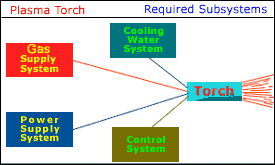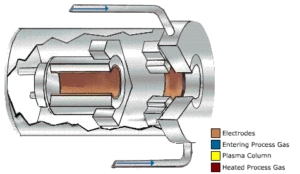Industrial Plasma System
The ATC System for industrial applications consists of five integral subsystems. These include:
- Plasma torches for conversion of electrical energy to process heat by direct heat transfer between a rapidly rotating electric arc and a process gas stream
- Power supply with electrical characteristics designed to match those of the plasma torch
- Control and instrumentation system for interlocking the necessary subsystems and to provide for acquisition of performance data
- Cooling water system for removal of the heat losses
- Gas system to furnish the process gas to be heated
A plasma torch consists of a closely spaced pair of tubular water-cooled electrodes within which an electric arc discharge is magnetically rotated at extremely high speeds.
During operation, a process gas is injected into the plasma torch through a spacing (approximately 1mm) between the electrodes.
Spark-over between the electrodes initiates the arc discharge when the power supply is energized.
The arc is immediately blown to the interior of the electrode by the incoming process gas. The arc current interacts with a magnetic field established by solenoid field coils located around both the upstream and downstream electrodes to rotate the arc at approximately 1000 revolutions-second.
The combination of high arc rotation speeds and high gas flow rates provides excellent heat transfer between the electric arc and the incoming process gas while also maximizing electrode life.
It is this excellent arc/gas interaction, which produces the superheated process gas and leads to the high thermal efficiencies obtained for this type of torch. The superheated gas exits at the downstream end of the torch.
The downstream electrode end can be designed to protrude through the refractory lining of a furnace or process reactor. The torch interfaces to the furnace or reactor by means of a mounting flange.
Cooling water and process gas connections are made at the torch-mounting flange and power connections are made at the upper end of the external cover. All connections are designed for quick assembly and removal to minimize servicing effort.
Complete servicing will consist of electrode and electrode seal replacement, followed by a water pressure leak test.

